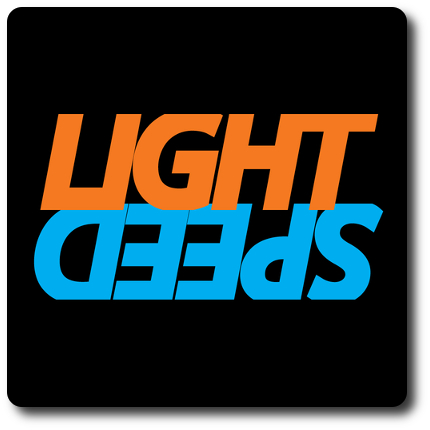
The Basics:
- For ages 6 and up (designer suggests 8+)
- For 2 players
- Approximately 15 minutes to complete
Geek Skills:
- Counting & Math
- Logical & Critical Decision Making
- Strategy & Tactics
- Visuospatial Skills
- Hand/Resource Management
- Worker Placement & Area Control
Learning Curve:
- Child – Easy
- Adult – Easy
Theme & Narrative:
- None
Endorsements:
- Gamer Geek approved!
- Parent Geek approved!
- Child Geek approved!
Overview
In the blink of an eye, your world could change. Nothing is for certain. We plan and we scheme, but all it takes is one unknown to throw everything off. But the human mind quickly adapts. New challenges result in new solutions. We overcome obstacles and persevere when everything to the contrary suggests that failure is the only possible outcome. In this game, every choice could lead to disaster or a brilliant opportunity, but victory is never certain.
LightSpeed, designed and self-published by Tanner Griffin, is comprised of 4o tiles, 6 Player Color tiles (3 each in 2 different colors), and 6 Player markers (3 each in 2 different colors). The artwork is minimal and professional looking. As this is a Print and Play game , it’s impossible for me to suggest the quality of the game components. The final quality of the game will depend on how much time and attention you put into it.
Game Set Up
To set up the game, first find and separate 5 “Single Circle” tiles. Place them in a configuration in the middle of the playing area so they match the following image.

Second, give to each player their 3 Player Color tiles and shuffle the remaining tiles. From the deck, give each player 3 tiles, face-down, which are added to the Player Color tiles. Players should look at their tiles, but keep them hidden from their opponent at all times.
Third, place the remaining deck of tiles to one side of the game playing area, face-down. This is the tile draw pile for the duration of the game.
Fourth, give to each player 3 Player markers that match the color of their Player Color tiles. Six are provided, but you are welcome to replace them with a glass bead or any other marker type. For example the Pawn pieces from a Chess game.
That’s it for game set up. Determine who should go first and begin.
Faster Than Light
A single game of LightSpeed is comprised of 2 phases. Each phase is completed by players taking turns. Each phase is summarized here.
Phase 1: Build
The first phase of the game is all about building the game playing area. On a player’s turn, they will complete one of the following 2 actions. The phase ends once all the tiles are placed to the table.
Option 1: Play a Tile
The player selects one of the 3 tiles (not one of their Player Color tiles) and places it so it’s adjacent to at least one tile already in the playing area. Note that the lines do not need to connect. The lines and the circles on the tiles will be used during the second phase of the game.
After the player places a tile, they draw a new one from the tile draw pile if possible. This completest the player’s turn. The next player now goes.
Option 2: Play a Player Color Tile
The player takes 1 of their Player Color tiles and places it so it’s adjacent to at least one tile already in the playing area. Note that the lines do not need to connect. The player then takes one of their Player markers and places it in the center of the Player Color tile. Players do not draw a new tile from the tile draw pile to replace their Player Color tile.
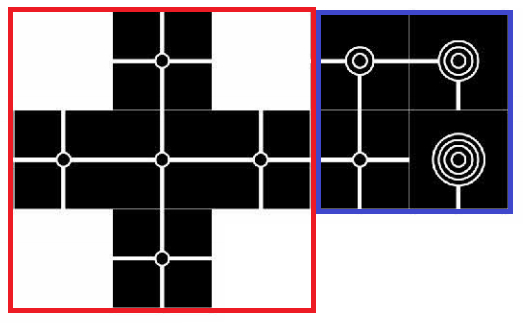
Tiles in the red box were those initially placed during game set up. The four in the blue box are the tiles added by the players during the first phase of the game.
This completest the player’s turn. The next player now goes. If all the tiles have been played, the second phase begins.
Phase 2: Destroy
The second phase of the game destroys the game playing area, with the players collecting the tiles they have placed. The player who placed their tile second during the first phase goes first during the second phase.
The lines and circles on the tiles are the primary focus of the second phase. The lines show travel routes and the circles will count as points at the end of the game. On a player’s turn during the second phase of the game, they will take 2 actions using 1 of their Player markers. The actions are summarized here.
Move
Using one of their 3 Player markers, the player will move it along the white lines that connect the tiles. The player can move their Player marker as far as they want, as long as the white lines the marker travels on are connected and the player’s Player marker does not move over their opponent’s Player marker.
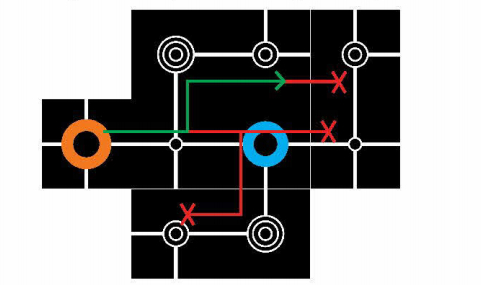
Green lines show valid movement paths for the “Orange” Player maker
When the Player marker comes to a rest, it’s placed on the center of the tile it stops on.
Shoot
Pick up a tile that is connected to the Player marker that was just moved by a continues straight white line. An opponent’s Player token is considered a “wall” that does not allow the player to target tiles past them.
Once the player selects a tile, they remove it and place it face-down in front of them. The number or circles on the tile (1, 2, 3, or 4) will count as points at the end of the game.
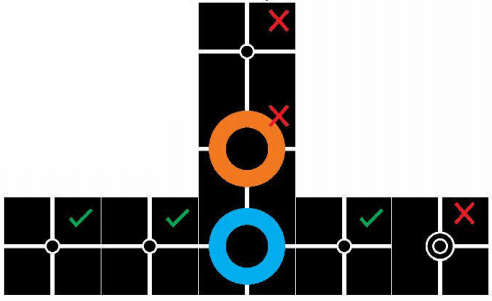
“Blue” Player could shoot and remove any tile with a green check mark
Note that the player who goes first during the second phase does not get to take the shoot action after their first move.
Coming to a Stop
The game ends when both players agree there are no more moves or tiles that can be removed. The players now take any tiles their Player markers are on and add them to the tiles they have collected during the second phase. The number of circles on the tiles is equal to the number of points the tile is worth.
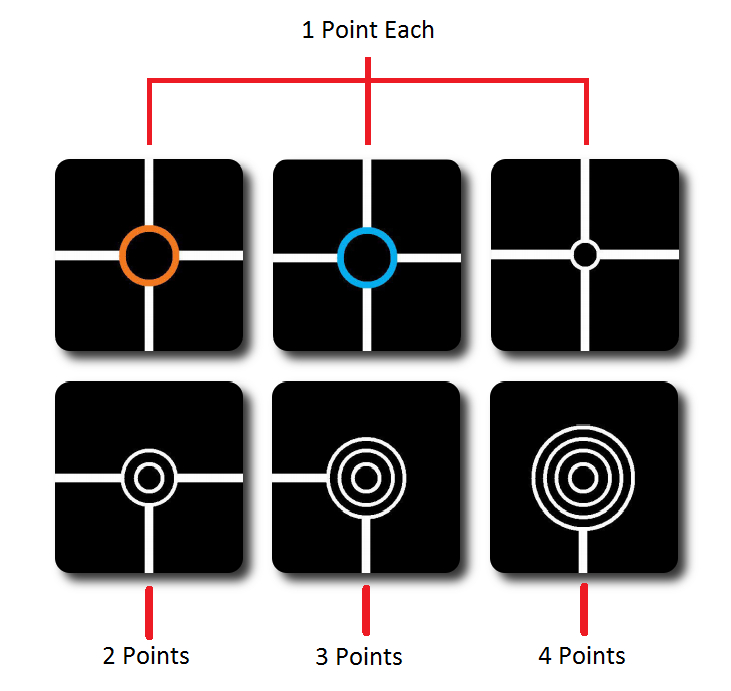
After the players have added up their circles on their tiles, the player with the most points wins the game.
To learn more about LightSpeed, download the rules, and the sheets that can be printed off to build your own copy of the game (for free), see the game’s entry on Board Game Geek.
Prediction
Reviewing the merits of a Print and Play game objectively can be difficult. Games of this type come with an unshakable reputation of being poorly designed and seldom tested. Automatically perceiving any Print and Play game as “bad” is not fair, but it’s also not always incorrect. There are many Print and Play games available to you today and many of those are, arguably, not worth printing. As such, my groups will have a few preconceived assumptions – as well as biases – against this game before it’s even put on the table.
The game itself appears to be solid if we base its value on the rules and suggested game play. The two-phased approach requires the players to think strategically and tactically. I rather like this and I think it’ll be well received by the Gamer Geeks if the game plays as tightly as it sounds. I also think the Parent Geeks will enjoy it, but the only group I am not sure of is the Child Geeks. The game’s strategy is very abstract, which might result in the Child Geeks not really “getting it”. Visually, it’s very clear what the tiles are doing and how they are connected. At the very least, the Child Geeks will understand how to build and how to destroy, but not necessary realize the value of the initial set up or the importance of how one should go about breaking it down for maximum points.
The game rules are very light and short. I have asked my oldest little geek to read them and teach me the game. While he is under the recommended age minimum, he is more than capable of playing this game. After reading the rules, he explained them to me with a few visual examples. I understood how the game should be played based on his direction without issue. I then asked him to teach his younger brother who is 6-years-old. Again, no issues understanding the rules. If nothing else, LightSpeed is certainly easy to teach.
And so, after the game was taught, I asked my little geeks what they thought of LightSpeed so far.
“Easy tile game, but I really like how we get to destroy what we build in round 2!” ~ Liam (age 9)
“You said this was like Tron. This is nothing like Tron.” ~ Nyhus (age 6)
I told my little geeks that LightSpeed was a bit like the movie Tron. Specifically, the Light Cycles that run on straight lines and create walls. My little geeks disagreed. Let’s play LightSpeed and see if it takes our breath away or we crash into a thousand pixels.
Final Word
The Child Geeks rather enjoyed the game. The two different phases both felt and played very differently. The first phase is like setting up the battlefield. The more savvy Child Geeks realized that they needed to create paths to points, as well as block their opponent from doing the same. Most of the time, this process appeared to be just random tile placement, but as the number of games played increased, so too did the strategies. The second phase is all about executing your strategy and using tactical moves to adjust for your first phase’s shortcomings. The second phase was by far the favorite, but also the most exasperating for the Child Geeks. Several times, a more cunning older Child Geek or Parent Geek would quickly limit the area in which the Child Geek could move. For some, this resulted in the less experienced players being shut out early. But, again, the most savvy of the Child Geeks realized that you had to cut the opponent off using as few tiles as possible, so as to allow for maximum freedom. This is a lot tougher than it sounds, as each tile that is removed not only counts as points, but also reduces options. Only the youngest of the Child Geeks didn’t like the game, while the vast majority did. According to one Child Geek, “This is a really neat game!”. So neat, in fact, that LightSpeed was approved by the Child Geeks.
Interesting side note that I think is worth sharing. My oldest little geek, who is a budding game designer in his own right, didn’t understand the importance of using the initial 5 tiles during the game set up. He wanted to see if the specific tile placement was necessary to the game play. In his own words, “I don’t know why you have to set up the tiles before you play. I don’t think it’s necessary.” Excellent. I have always told my children to ask “why” and think for themselves. I am most pleased to see he wants to challenge Mr. Griffin’s game design. To test my little geek’s theory, we separated the Player Color tiles, but didn’t place the initial 5 tiles. We instead just started to play. The first phase went very smoothly. The second phase did not. Turns out the initial 5 tile set up is essential to the second phase of the game as it provides a necessary center “gateway” for the players to move their Player markers. Without the “gateway”, our Player markers were quickly separated and the game felt significantly less intense. This satisfied my little geek’s curiosity and he felt he learned something important about game design. According to him, “All games need a starting point, otherwise, you’ll get lost.” Good grief, that’s deep.
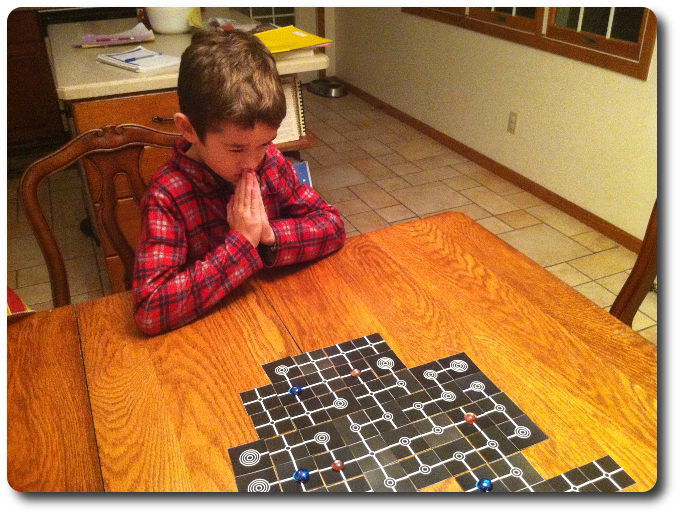
We try my little geek’s attempt to “break the game” – It broke us during the second phase of the game…
The Parent Geeks picked up on the game’s subtle tactics and strategy right away, but not everyone used it. Some of the more casual and non-gamer Parent Geeks simply built the playing area to help connect circles and didn’t do much to put roadblocks in their opponent’s path. The well seasoned Parent Geeks who enjoyed a good strategic and tactical game, jumped right into LightSpeed and demonstrated some excellent strategy and tactics right from the start. These games were surprisingly competitive and intense, complete with many groans, moans, and colorful language. Games against their peers was more times than not very competitive, with games against their Child Geeks a much more casual experience. In the end, all the Parent Geeks voted to approve LightSpeed. According to one Parent Geek, “This is an excellent game. I’m going to download it and make it this weekend!”
The Gamer Geeks are, by default, very skeptical of Print and Play games, and with good reason. Many Print and Play games are actually publicly released games that are unfinished, woefully under play-tested, and lack much in the way of refinement. LightSpeed surprised them. They didn’t think much of the game’s simple presentation and described game play. When the game was played in front of them, they immediately understood the importance of the two different game phases. More to the point, they saw how well-balanced and designed the game was. According to one Gamer Geek”, this is an excellent example of putting together simple game mechanics to create a surprisingly deep strategy game. This is a lot of fun.” All the Gamer Geeks agreed that LightSpeed was an excellent 2-player game and was perfect for casual game nights or killing time the Gamer Geek way.
Everyone was very pleased with LightSpeed, and so was I. At first, however, I didn’t think much of it. LightSpeed arrived in a plain envelope and the game was packed in a small box that was mostly destroyed. The game also didn’t include any instructions, which left me with nothing more than the tiles, a few Player markers, and a torn up box. As far as first impressions go, LightSpeed failed to make a good one. But, as I always tell my Child Geeks, “never judge a book by its cover.” Or, in this case, it’s torn up box. I was very excited when LightSpeed turned out to be so very much more than the sum of its parts. It has provided a great deal of enjoyment, lots of challenging decisions, and some rememberable moments. I highly recommend you download the freely available game components today and make yourself a copy. Do spend the time making the pieces right, too. Cut them out carefully and mount them on solid tiles. You’ll be wanting to play LightSpeed for a long time, and the better you make it, the more you’ll enjoy it.
This game was given to Father Geek as a review copy. Father Geek was not paid, bribed, wined, dined, or threatened in vain hopes of influencing this review. Such is the statuesque and legendary integrity of Father Geek.




Pingback: Today in Board Games Issue #91 - Today in Board Games